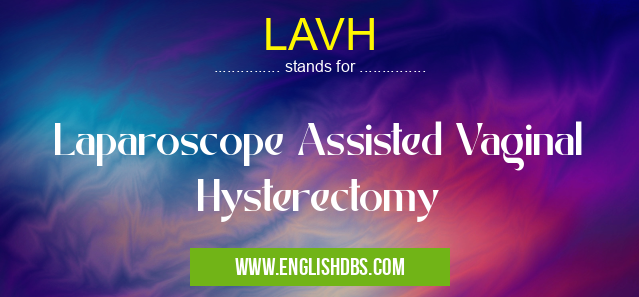What does LAVH mean in UNCLASSIFIED
LAVH stands for Laparoscopic Assisted Vaginal Hysterectomy. It is a minimally invasive surgical procedure that involves removing the uterus (womb) through the vagina with the assistance of a laparoscope.

LAVH meaning in Unclassified in Miscellaneous
LAVH mostly used in an acronym Unclassified in Category Miscellaneous that means Laparoscope Assisted Vaginal Hysterectomy
Shorthand: LAVH,
Full Form: Laparoscope Assisted Vaginal Hysterectomy
For more information of "Laparoscope Assisted Vaginal Hysterectomy", see the section below.
What is LAVH?
LAVH is a hybrid surgical technique that combines the advantages of both laparoscopic and vaginal hysterectomies. During the procedure:
- Small incisions are made in the abdomen.
- A laparoscope, a thin lighted instrument, is inserted through one incision to visualize the uterus.
- Surgical instruments are inserted through other incisions to detach the uterus from surrounding tissues.
- The uterus is then removed through the vagina.
Advantages of LAVH
Compared to traditional open hysterectomy, LAVH offers several advantages:
- Minimal Incisions: Smaller incisions result in less pain, scarring, and a faster recovery time.
- Reduced Blood Loss: The laparoscopic approach allows for greater precision, minimizing blood loss.
- Shorter Hospital Stay: Patients typically stay in the hospital for 1-2 days after LAVH, compared to 3-5 days for open hysterectomy.
- Faster Recovery: Recovery time is typically shorter, with most patients returning to normal activities within a week or two.
Indications for LAVH
LAVH is commonly used to treat conditions such as:
- Uterine fibroids
- Endometriosis
- Uterine prolapse
- Abnormal uterine bleeding
Procedure Duration
The duration of LAVH varies depending on the complexity of the case, but typically takes 1-2 hours.
Recovery
After the procedure, patients may experience some discomfort and vaginal bleeding. Pain medication and rest are recommended during recovery. Most women can resume light activities within a week, but strenuous activity should be avoided for several weeks.
Essential Questions and Answers on Laparoscope Assisted Vaginal Hysterectomy in "MISCELLANEOUS»UNFILED"
What is a Laparoscopic Assisted Vaginal Hysterectomy (LAVH)?
A minimally invasive surgical procedure to remove the uterus (womb) through the vagina with the assistance of a laparoscope.
Who is a candidate for LAVH?
Women with benign conditions such as uterine fibroids, endometriosis, or uterine prolapse, who are not planning to have more children.
What are the advantages of LAVH compared to traditional hysterectomy?
Smaller incisions, less pain, shorter recovery time, and reduced risk of complications.
How is a LAVH performed?
Through small incisions in the abdomen, a laparoscope (a thin camera) is inserted to visualize the uterus. The uterus is then removed vaginally.
What is the recovery time after LAVH?
Typically 1-2 weeks, with full recovery within 6-8 weeks.
What are the risks and complications associated with LAVH?
As with any surgery, there are risks such as bleeding, infection, and anesthesia complications. Specific risks include vaginal cuff dehiscence (separation) and injury to surrounding organs.
When should I seek medical attention after LAVH?
If you experience any symptoms such as fever, chills, excessive bleeding, or severe pain, seek medical attention promptly.
What are the long-term effects of LAVH?
LAVH does not affect fertility as it preserves the ovaries. However, it can lead to vaginal dryness and loss of sexual desire in some women.
Are there any alternatives to LAVH?
Yes, there are other surgical approaches to hysterectomy, such as abdominal hysterectomy or robotic-assisted hysterectomy. Your doctor will recommend the best option based on your individual situation.
Final Words: LAVH is a safe and effective minimally invasive surgical option for removing the uterus. Its advantages over traditional open hysterectomy include minimal incisions, reduced blood loss, shorter hospital stay, and faster recovery.
